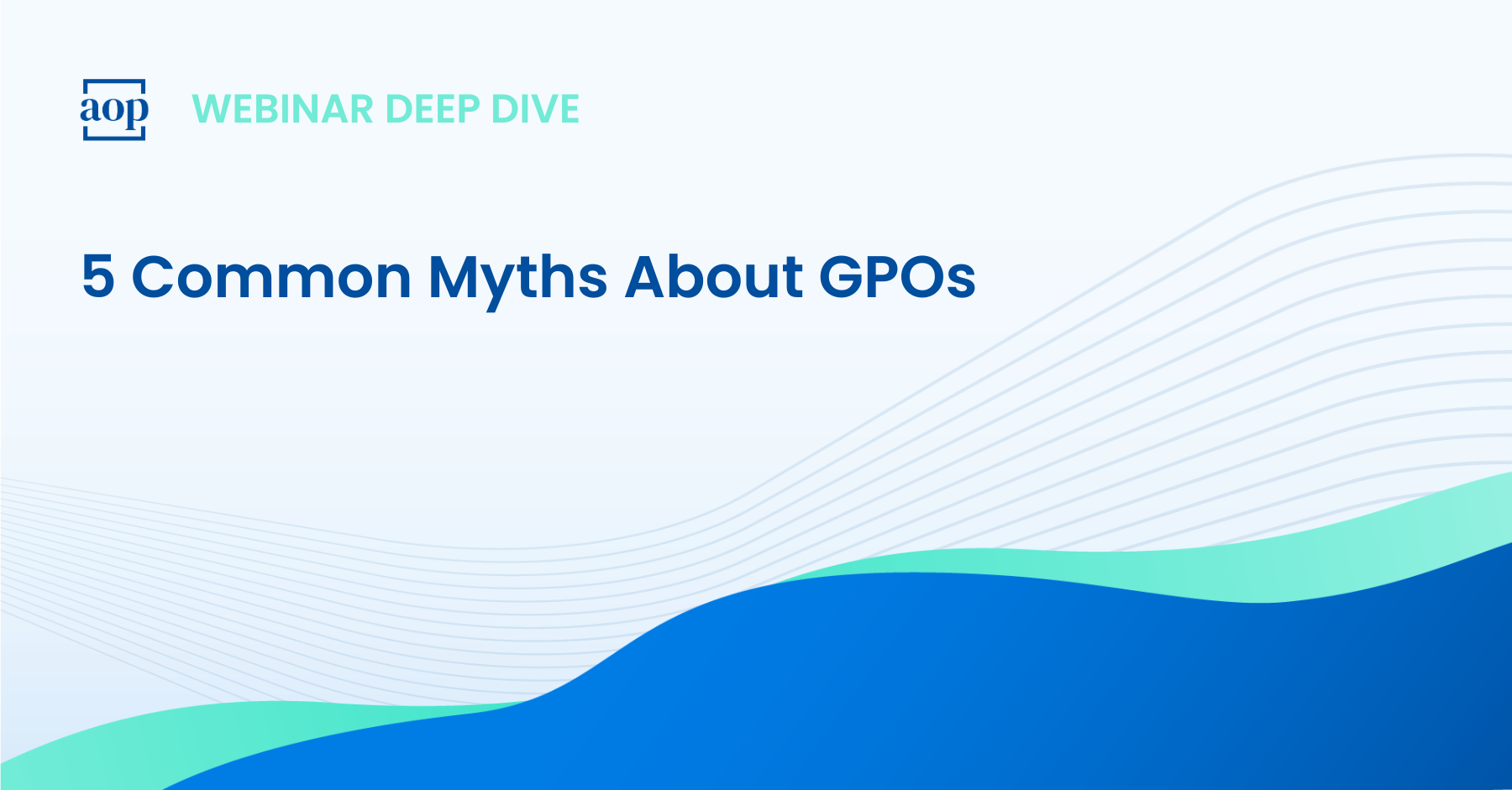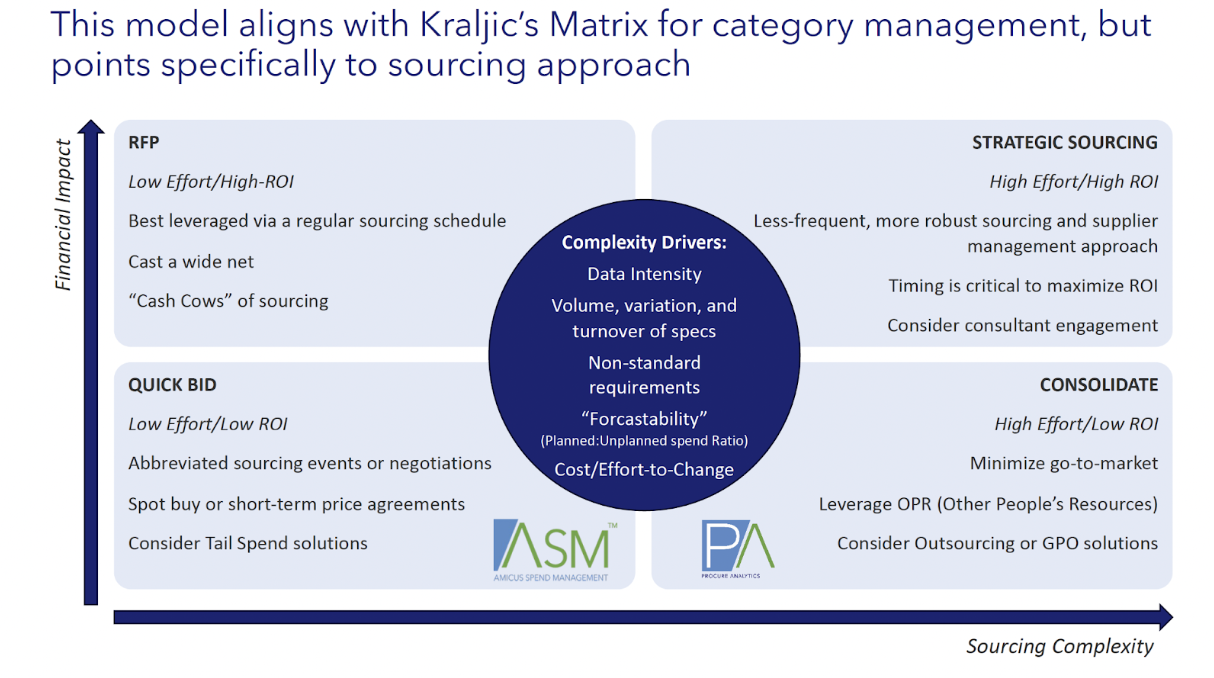
At Categorypalooza 2023, Brian Halpin, VP and General Manager at Procure Analytics, led a session on the complexities and opportunities associated with Group Purchasing Organizations. GPOs are frequently misunderstood by procurement practitioners, but leading consultants see them as a critical component of any comprehensive category management program.
During his session, Brian dispelled several common misconceptions about GPOs and discussed how top procurement consultants leverage GPOs to maximize spend addressability and accelerate speed to savings for their clients. The takeaways were so insightful that we asked him to share some of his notes in the form of a Q&A.
Q: What is a GPO?
A: A leveraged purchasing program where many companies pool their purchasing requirements to combine their leverage and optimize pricing.
Q: What benefits are typically associated with GPOs?
The GPO acts as an agent on behalf of its individual members and collective membership. This results in leveraged pricing, preferred payment terms, free or reduced cost services such as shipping, vendor managed inventory, rebates, and year over year savings. Members also receive enhanced reporting and spend visibility, spend analytics, and program and project management support.
Q: Can you give us a list of the most common myths about GPOs?
A: The myths around GPOs I hear most often include:
Myth 1: GPOs only benefit suppliers: While there is truth to the notion that suppliers use GPOs as a sales channel, the benefits flow to the member as well. There is a lower cost to suppliers to sell and to serve members because the GPO is providing account management resources, and this gets reflected in the price offered to members. Also, GPOs themselves are constantly negotiating better terms with their supplier partners on behalf of their members, particularly as their membership and buying power increases. They periodically take each relationship to market to ensure that the GPO is offering the best supplier set and solutions to the membership.
Myth 2: GPOs only benefit small companies who can ride on the volume coattails of big companies: Prices aren’t indexed off of the highest volume member, but rather the collective buying volume. No matter how large your spend is, you’ll never have the purchasing power of a thousand companies. Additionally, each company’s product mix is different – often smaller companies in different industries will have high spend in subcategories that aren’t high volume for your business, so larger companies can still benefit from smaller company spend.
Myth 3 My business is unique – GPO pricing is a catalog approach and is not fit for my product mix and service requirements: Every business is unique to some degree. Regarding product mix, even if your product needs vary from the collective membership, you are still benefiting from aggregate volume leverage. Leading GPOs frequently negotiate on behalf of individual members to ensure their product and their service needs are addressed.
Myth 4: The only value GPOs provide is price discounts: In addition to the non-price benefits already mentioned – account support, spend visibility, value added services, and improved commercial terms – a good GPO is an outsourced category management team, providing talented and experienced resources that actively manage your spend, advocate for you with suppliers, and drive value-added activities.
Myth 5: Strategic sourcing events are the only way to optimize savings: Running an individual sourcing event limits your savings potential to your purchase volume and product mix. Additionally, running a sourcing event, particularly in a highly complex category like MRO, is massively time consuming. We know that suppliers are highly adept at playing the RFP process to their advantage, baking high potential savings into a limited market basket of goods reflected in the RFP, and margining up on the non-RFP products that often result in 40-60% of actual spend, meaning that identified savings levels are rarely realized.
Q: One thing many procurement professionals may not know is that GPOs are heavily leveraged by consultancies… Why is that?
A: We work with a number of leading procurement practices, and we have found that scoping and executing sourcing events in certain spend categories is a poor use of their resources and, by extension, their clients’ consulting dollars. GPOs offer speed to savings not attainable via RFP.
Q: How do consultants evaluate spend for potential GPO solutions?
A: Consultants typically start by reviewing a client’s spend file putting that spend through a set of filters to identify savings potential, and they evaluate the effort associated with running an effective savings program.
Many in our audience are probably familiar with the common four-box category management model known as Kraljic’s Matrix. That model addresses how to segment a spend portfolio for an appropriate spend management approach. Consultants take a similar approach but are more specifically looking at how to drive savings for their clients within a given scope of work – meaning they have a limited amount of consulting hours and budget within which to deliver successful savings results to their client, so that they can deliver the expected ROI.
 This model shows how consultants evaluate their programs. Clearly, they need to have their resources allocated more heavily to the high impact categories in the top half of this graphic.
This model shows how consultants evaluate their programs. Clearly, they need to have their resources allocated more heavily to the high impact categories in the top half of this graphic.
Where high savings can be delivered quickly through a simple RFP approach, as in the upper left, then a small allocation of lower cost/less experienced consultants can typically run a playbook approach and generate strong results. This frees the heavy hitter resources to run higher effort, strategic plays on highly visible categories that require a more nuanced, strategic approach. This is where they can highlight their capabilities and deliver game-changing results.
That leaves few resources to address the lower value categories. Sometimes these are simply left out of scope. However, better consultancies recognize that if they can offer solutions that deliver savings and process efficiency quickly and with minimal investment of their consulting hours, it maximizes the ROI that they can deliver. This can increase their revenues in gain share arrangements while giving them the ability to track reportable savings to their client stakeholders, all while they are executing on higher value sourcing events that can take 3-6 months to deliver results. GPOs and third-party solutions such as tail spend optimization programs are ideal for these purposes.
Q: When does it make sense to use a GPO for sourcing versus the internal management of a category or supplier?
A: Enterprise procurement organizations are similar to consultancies in that they have limited resources, big savings targets, and tight timelines. The best procurement organizations run their operations much like a consultancy. As procurement professionals, I’d urge you to become familiar with the leading GPOs and the categories where they provide mature programs. Not all categories are good candidates or well-represented by GPOs, and not all spend profiles are a great fit.
Q: Are there any surprising categories of spend that can actually be well managed through a GPO?
I’d be challenged to name a category that would be truly shocking, but there are some that are pretty niche. I will note that we recently added whitewood pallet programs, which had long been considered a category that cannot be nationally consolidated.
Watch the session in full here.




